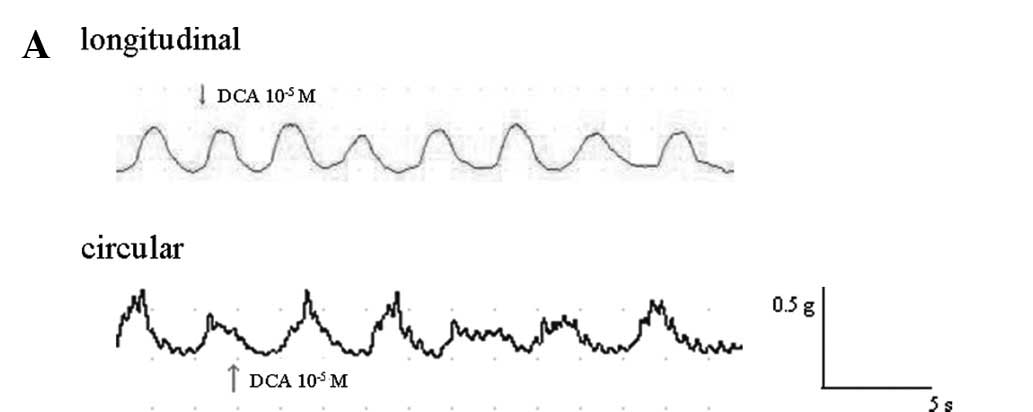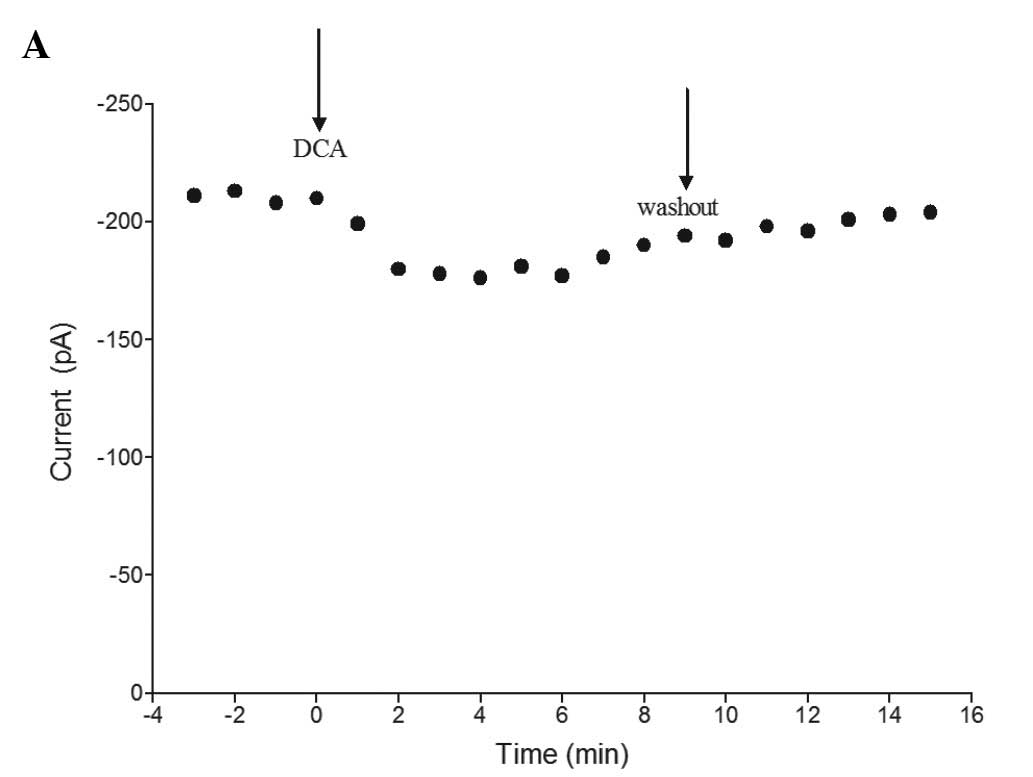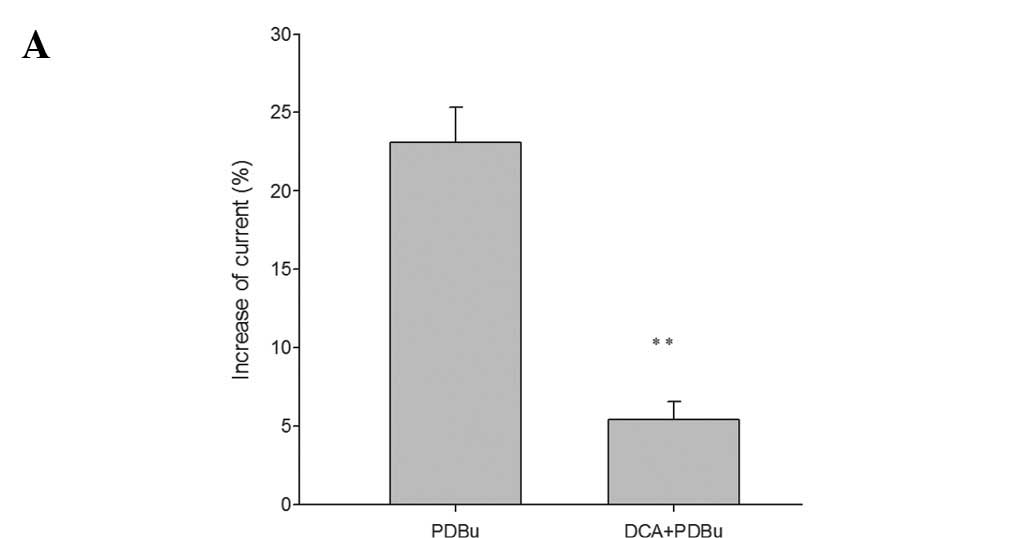Deoxycholic acid inhibits smooth muscle contraction via protein kinase C-dependent modulation of L-type Ca2+ channels in rat proximal colon
- Authors:
- Published online on: July 11, 2012 https://doi.org/10.3892/mmr.2012.984
- Pages: 833-837
Abstract
Introduction
Bile acids are synthesized from cholesterol and are conjugated to either taurine or glycine. The primary bile acids are dehydroxylated by intestinal bacteria, which gives rise to secondary bile acids, including deoxycholic acid (DCA). Most bile acids are absorbed from the terminal ileum and are returned to the liver by enterohepatic circulation. Several bile acids, malabsorbed by the small intestine, are transported to the colon where they affect colonic motility. In certain pathological conditions, for example, irritable bowel syndrome and ileal surgical resection, bile acid reabsorption is compromised. Previous studies suggested that bile acids affect gastrointestinal motility (1–3). Bile acids have been reported to inhibit ileal motility in the isolated perfused rabbit terminal ileum and guinea pig gallbladder smooth muscle strips (1,2). Moreover, DCA has been shown to inhibit spontaneous mechanical contractions in canine colonic smooth muscle (3).
In non-muscle cells, bile acids act through a variety of signaling mechanisms, including the activation of protein kinase C (PKC) or cyclooxygenase, or the generation of reactive oxygen species (ROS) (4–6). DCA inhibits the pacemaker currents of the interstitial cells of Cajal (ICC) by activating KATP channels through the production of PGE2(7). L-type Ca2+ channels in intestinal smooth muscle are thought to trigger contractile activity. Intestinal smooth muscle contractility is dependent on the activation of L-type Ca2+ channels, which result in Ca2+ entry and the initiation of contractions (8). The effects and mechanism of DCA activity on the contraction of colon smooth muscles are not completely understood. Our aim was to investigate the possible mechanism by which DCA affects colon motility in vitro.
Materials and methods
Animals
Male Wistar rats weighing 200–250 g were used in this study. Rats were given free access to food and water in a temperature- and relative humidity-controlled room (23–25°C, relative humidity 55–60%) with a 12-h light/dark cycle for 1 week. Animals were maintained according to animal care guidelines from the Institutional Animal Care and Use Committee of Wuhan University. Approval was obtained from the ethics committee of Wuhan University.
Preparation of colonic strips
Rats were anesthetized with ethyl ether prior to cervical exsanguination. The proximal colon was cut along the mesenteric border and cleaned with Ca2+-free physiological saline solution (PSS). Muscle strips (~3×10 mm) were removed and placed in Ca2+-free PSS, which was oxygenated continuously. Following the careful removal of the mucosa and submucosa by dissection, smooth muscle strips were obtained.
Contraction recording of colonic smooth muscle strips
Following the method described in our previous study (9), the muscle strips were mounted in 7 ml Tyrode’s solution and connected to an isometric force transducer (JZJOIH, Chengdu, China). The Tyrode’s solution was kept at 37°C and bubbled with carbogen (95% O2 + 5% CO2). A tension of 1.0 g was slowly applied to the muscle strips prior to drug treatment. The muscle strips were allowed to equilibrate for 30–60 min, with the solution being changed every 20 min. The strips were washed at least three times with Tyrode’s solution between each experimental condition. The mean contractile amplitude and frequency were recorded as control values and the effects of drugs as response values. The results were presented as the percentage change, calculated as: percentage change = (response value - control value)/control value × 100%.
Cell isolation
Colon smooth muscle cells (SMCs) were dissociated by enzymatic digestion according to a previously described method (10). The colon tissue was pinned to the Sylgard surface of a Petri dish and the mucosa was carefully dissected away under an anatomical microscope. The smooth muscle strips were then cut into small strips (2×2 mm) and placed in 2 ml calcium-free PSS supplemented with 0.12% (w/v) collagenase (type II), 0.2% soybean trypsin inhibitor and 0.2% bovine serum albumin (BSA), and incubated for 20–30 min at 37°C. Pieces of tissue were rinsed in Ca2+-free PSS solution five times to remove the enzyme, and were maintained at 4°C for 6 h until use. Single SMCs were isolated by several gentle triturations through the tip of a fire-polished Pasteur pipette.
Whole-cell patch clamp recordings
For patch-clamp recordings, colon SMCs were placed onto glass coverslips. After being allowed to adhere to the glass for 10 min, the cells were washed with bath solution at a rate of 3 ml/min. The ion channel currents were recorded using a conventional whole-cell patch clamp method with an EPC-10 amplifier (HEKA Instruments Inc., Bellmore, NY, USA). Typical pipette resistances were 3–5 MΩ. Data were filtered at 200 Hz and digitized at 10 KHz (filter 1) and 2.9 KHz (filter 2). The experiments were performed at 24±1°C, and the temperature of the bath solution ranged from 20 to 22°C. L-type Ca2+ currents were activated by step depolarisation every 10 sec from a holding potential of −80 or −60 mV, between −40 and +30 mV for 400 ms in 10-mV increments to obtain current-voltage (I-V) relationships.
Solutions and drugs
The cells were bathed in a solution (Tyrode’s solution) containing (mM): NaCl, 147.0; KCl, 4.0; CaCl2, 2.0; NaH2PO4, 0.42; Na2HPO4, 1.81; MgCl2, 1.05; and glucose, 5.5 (adjusted to pH 7.35 with NaOH). The pipette solution contained (mM): CsCl, 135; MgCl2, 4; HEPES, 10; Na2-ATP, 2; EGTA, 10; and tetraethylammonium (TEA), 20 (adjusted to pH 7.3 with Tris base). The Ca2+-free PSS contained (mM): NaCl, 135; KCl, 5.0; MgCl2, 1.2; glucose, 10.0; and HEPES, 10 (adjusted to pH 7.4 with NaOH). The drugs used were: acetylcholine (Ach), DCA, nifedipine, chelerythrine and phorbol 12,13-dibutyrate (PDBu), and were purchased from Sigma (St. Louis, MO, USA). Collagenase was purchased from Gibco (Invitrogen Life Technologies, Carlsbad, CA, USA). Nifedipine, chelerythrine and PDBu were prepared as stock solutions in dimethylsulfoxide (DMSO) and stored at −20°C. The final concentration of DMSO used in the experiments was <0.03%, which had no effect on the strips and cells.
Statistical analysis
The drug-induced changes in contractile response relative to the basal levels were calculated as percentages, and all values were expressed as the mean ± standard error (SE). Differences in the data were evaluated by the Student’s t-test. P<0.05 was considered to indicate a statistically significant result. The n values reported in the text refer to the number of cells used in patch-clamp experiments.
Results
Effects of DCA on contractions of proximal colon smooth muscle strips
DCA decreased the amplitude of spontaneous contractions of the proximal colonic smooth muscle (PCSM) strips in a concentration-dependent manner, but not the frequency of the spontaneous contractions. DCA affected the contraction of the strips when applied for 2–3 min. Fig. 1A shows representative traces which demonstrate the effect of DCA (10−5 M) on the resting tension of longitudinal and circular muscle strips.
The mean contractile amplitude of longitudinal muscle was reduced by 5.63±2.77, 10.95±2.76 and 19.89±3.33% at DCA concentrations of 10−6, 10−5 and 10−4 M, respectively (all n=6; p<0.05). The contractile amplitude of circular muscle was reduced by 5.22±1.63, 14.84±2.09 and 21.15±3.28%, respectively (all n=6; p<0.05) (Fig. 1B).
When the contraction evoked by Ach or KCl had reached a plateau, DCA (10−5 M) was administered. The administration of DCA induced the relaxation of PCSM (followed by circular muscle) strips pre-contracted with Ach (10 μM) or KCl (80 mM) by 12.2±1.5%, p<0.05 and 16.3±6.9%, p<0.05, respectively. Data were expressed as the percentage changes in tension from the contraction induced by Ach or KCl, respectively.
Increasing the concentration of CaCl2 resulted in a concentration-dependent contraction of the strips. Incubation with DCA (10−5 M) for 20 min shifted the concentration-response curves of CaCl2 to the right and decreased the maximal response (Fig. 1C).
Pre-treatment of proximal colonic strips with the PKC inhibitor chelerythrine for 20 min significantly attenuated the effects of DCA (10−5 M) on the Ach-induced contractions (Fig. 1D).
Effects of DCA on L-type Ca2+ currents in colonic smooth muscle
L-type calcium current (ICa-L) was recorded with calcium as the current carrier when the pipette contained a high-Cs solution. The maximum current reached ~0 mV under these conditions, and was depressed by nifedipine (10 μM) by ~80% (n=6; p<0.05). The average cell capacitance (Cm) was 60.007±20.17 pF (n=60) and the access resistance was 5–10 MΩ. A series resistance compensation (lag of 60 us) of 70–75% was applied during each recording.
When DCA (10−5 M) was applied for 2–3 min, the peak ICa-L was reduced. As time increased, ICa-L reduced to a steady state level and was partially restored following a long-time washout. Fig. 2A shows the time-dependent effect of DCA in a representative cell. The currents were evoked by a step to 0 mV from a holding potential of −40 mV.
As shown in Fig. 2B, current traces were obtained under control conditions and during superfusion with DCA at concentrations from 10−6 to 10−4 M. Fig. 2C shows that DCA suppressed the ICa-L at 0 mV by 6.02±0.87, 15.02±1.73 and 47.14±3.79% at concentrations of 10−6-, 10−5 and 10−4 M, respectively (all n=6; p<0.05).
Fig. 2D shows the average steady-state I-V relationships in the presence and absence of 10−5 M DCA, indicating that the drug did not change the shape of the I-V curve. When DCA was applied, the amplitude of the peak current was decreased from 213±4.6 to 181±4.9 pA compared with the control group (at 0 mV; n=6, p<0.05).
Effects of PKC on the action of DCA on ICa-L in colonic smooth muscle cells
To determine whether PKC was involved in the action of DCA, we used PDBu, a PKC activator, and chelerythrine, a potent PKC inhibitor.
Firstly, we tested the effects of PDBu (100 nM) and found that it promoted the ICa-L by 23.11±2.2% at 0 mV (n=6; p<0.05). The results demonstrated that PKC enhanced the L-type calcium currents in colonic SMCs. We then tested the effects of PDBu on the ICa-L in cells treated with DCA (10−5 M) for 3 min. We found that the promoting effect of PDBu on the ICa-L was reduced to 5.45±1.12% in the presence of DCA (Fig. 3A).
Secondly, pre-treatment of the colonic SMCs with the PKC inhibitor chelerythrine (1 μM) greatly reduced the decrease of ICa-L caused by DCA (10−5 M) (Fig. 3B). DCA decreased the ICa-L by only 3.57±0.35% in the presence of chelerythrine, compared with 15.09±1.65% in the absence of chelerythrine at 0 mV (n=6; p<0.05) (Fig. 1D). These results suggest that the inhibitory effects of DCA on the colonic SMC ICa-L are mediated by PKC.
Dissussion
In the present study, we investigated whether DCA inhibited the contraction of colonic smooth muscle strips in vitro and decreased ICa-L, possibly by the PKC pathway, in colonic SMCs.
It has been previously reported that concentrations of biliary DCA are increased in subjects with cholesterol gallstones, and that they alter gallbladder motor function (11). Therefore, it appears likely that DCA produced in the colon affects colonic motility. DCA has been shown to impair esophageal mucosal integrity via the induction of apoptosis (12). In our experiment, the effects of DCA were tested at concentrations of 10−6–10−4 M. KCl- and Ach-induced contractions of colonic smooth muscle strips were relaxed following the administration of DCA. The concentration-response curve of CaCl2 was shifted to the right by incubation with DCA. These results indicate that DCA substantially inhibits extracelluar Ca2+ influx.
The activities of ion channels closely correlate with the movement of smooth muscle. In the present study, we found that the ICa-L in colonic SMC was decreased by DCA in a concentration-dependent manner. In addition, the characteristics of the I-V curve were not significantly altered. The effects of DCA on calcium have been demonstrated in a previous study. For example, bile acids were shown to stimulate calcium mobilization through extracellular calcium influx and/or calcium release from intracellular organelles (as reviewed in ref. 13). Our patch clamp results directly demonstrate that DCA inhibits the contraction of smooth muscles through the reduction of calcium entry through L-type calcium channels. The possible effect of DCA on the release of calcium from intracellular organelles needs to be further investigated. Previous studies have indicated that DCA inhibits the pacemaker currents generated by interstitial cells of Cajal (ICC); interaction with the activating KATP channels in the ICC resulted in the suppression of intestinal motility (7). Variations in the channel suggest that DCA may possess differing tissue and channel effects. The activity of DCA on ICC is consistent with its effects on smooth muscles. Thus, we presume that DCA activates KATP channels in colonic smooth muscles, but further investigation is required. Inhibition was observed when applying DCA for 2–4 min, and partly recovered following washout; thus, we suggest that the activity of DCA is non-genomic.
PKC, which is involved in cell responses to various stimuli, including neurotransmitters, growth factors and hormones, is essential for cell proliferation, differentiation and the regulation of ion channels. In smooth muscles, PKC is important for the regulation of movement. It is well known that activation of PKC enhances ICa-L in a variety of smooth muscles (14). For example, cholecystokinin (CCK) increases the ICa-L of gastric abtrum via the PKC pathway (15). Results showed that incubation with chelerythrine significantly affected the action of DCA on colonic smooth muscle strips pre-contracted by Ach, while the promoting effects of PDBu on the ICa-L were reduced in the presence of DCA. The ICa-L in the presence of chelerythrine was not greatly reduced by DCA. The results indicate that DCA regulates the PKC pathway. We conclude that DCA reduces PCSM contraction and inhibits L-type calcium channels in smooth muscle cells. This activity appears to be mediated through PKC. Furthermore, this study suggests another possible mechanism for the bile acid-related modulation of gastrointestinal motility.
Acknowledgements
This study was supported by the Fundamental Research Funds for the Central Universities (Grant no. 20103020101000201). The authors also thank the Key Laboratory of Hubei Province for Digestive System Disease.
References
|
Armstrong DN, Krenz HK, Modlin IM and Ballantyne GH: Bile salt inhibition of motility in the isolated perfused rabbit terminal ileum. Gut. 34:483–488. 1993. View Article : Google Scholar : PubMed/NCBI | |
|
Xu QW, Freedman SM and Shaffer EA: Inhibitory effect of bile salts on gallbladder smooth muscle contractility in the guinea pig in vitro. Gastroenterology. 112:1699–1706. 1997. View Article : Google Scholar : PubMed/NCBI | |
|
Lee HK and Lee KH: Bile acid modulation of gastrointestinal smooth muscle contraction and ionic currents. Kor J Physiol Pharmacol. 4:333–338. 2000. | |
|
Sokol RJ, Winklhofer-Roob BM, Devereaux MW and McKim JM Jr: Generation of hydroperoxides in isolated rat hepatocytes and hepatic mitochondria exposed to hydrophobic bile acids. Gastroenterology. 109:249–256. 1995. View Article : Google Scholar : PubMed/NCBI | |
|
Zhang F, Subraramaiah K, Altorki N and Dannenberg AJ: Dihydroxy bile acids activate the transcription of cyclooxygenase-2. J Biol Chem. 273:2424–2428. 1998. View Article : Google Scholar : PubMed/NCBI | |
|
Zuh Y, Hua P, Rafiq S, et al: Ca2+- and PKC-dependent stimulation of PGE2 synthesis by deoxycholic acid in human colonic fibroblasts. Am J Physiol Gastrointest Liver Physiol. 283:G503–G510. 2002. | |
|
Jun JY, Choi S, Chang IY, et al: Deoxycholic acid inhibits pacemaker currents by activating ATP-dependent K+ channels through prostaglandin E2 in interstitial cells of Cajal from the murine small intestine. Br J Pharmacol. 144:242–251. 2005.PubMed/NCBI | |
|
Farrugia G, Rae JL and Szurszewski JH: Characterization of an outward potassium current in canine jejunal circular smooth muscle and its activation by fenamates. J Physiol. 468:297–310. 1993. View Article : Google Scholar : PubMed/NCBI | |
|
Xu L, Chen J, Yu BP, et al: Effect of progesterone on calcium activated potassium currents and intracellular calcium in guinea pig colon myocytes. Methods Find Exp Clin Pharmacol. 27:475–482. 2005. View Article : Google Scholar : PubMed/NCBI | |
|
Xu L, Yu BP, Chen JG and Luo HS: Mechanisms mediating serotonin-induced contraction of colonic myocytes. Clin Exp Pharmacol Physiol. 34:120–128. 2007. View Article : Google Scholar : PubMed/NCBI | |
|
Azzaroli F, Mazzella GF, Mazzeo C, et al: Sluggish small bowel motility is involved in determining increased biliary deoxycholic acid in cholesterol gallstone patients. Am J Gastroenterol. 94:2453–2459. 1999. View Article : Google Scholar : PubMed/NCBI | |
|
Huo X, Juergens S, Zhang X, et al: Deoxycholic acid causes DNA damage while inducing apoptotic resistance through NF-κB activation in benign Barrett’s epithelial cells. Am J Physiol Gastrointest Liver Physiol. 301:G278–286. 2011.PubMed/NCBI | |
|
Nguyen A and Bouscarel B: Bile acids and signal transduction: role in glucose homeostasis. Cell Signal. 20:2180–2197. 2008. View Article : Google Scholar : PubMed/NCBI | |
|
Cobine CA, Callaghan BP and Keef KD: Role of L-type calcium channels and PKC in active tone development in rabbit coronary artery. Am J Physiol Heart Circ Physiol. 292:H3079–H3088. 2007. View Article : Google Scholar : PubMed/NCBI | |
|
Si XM, Huang L, Paul SC, An P and Luo HS: Signal transduction pathways mediating CCK-8S-induced gastric antral smooth muscle contraction. Digestion. 73:249–258. 2006. View Article : Google Scholar : PubMed/NCBI |












